leading from
a) Why is Occator Crater here?
This should not be confused with a scientific claims, but instead is a statement about artistic observations and comparisons.
If
we had a detailed map of the crater with names for all of the various
little land formations, it would be very much easier to talk about the
comparisons to be made.
But the photographs are not very detailed and few names have been given to any of the features in order to say "Yes, I know that little place, that little corner or that curious land feature over there by name"
However
I wouldn’t have the answer to why I think that I should be able to make
these comparisons since as far as history understands, we didn’t have
the technology to see the place all those hundreds and thousands of years ago, and it
would be useless of me to claim we did without some form of evidence.
I may have overlooked something but we
don’t have accounts of perhaps any mysterious shamanistic visions or
out of body experiences that have talked about such a place in a way
that sound recognisable.
There
are no accounts of people in the bible being taken by angels to a
heavenly place before returning Earth to tell everyone about a place
that sounded suspiciously like Occator Crater.
But
most of the images that might seem similar to what we have seen of this
crater, looks as if the viewers had got no closer to it
than our Dawn space probe mission.
But
20th century artists such as Jack Kirby who drew something similar to it
as the mysterious city of the Eternals on top of Mount Olympia, were
able to produce pictures that mysteriously suggested that something of
this place could be experienced just by being in a creative state of
mind.
If
Occator crater turns out to be just another crater, with no ruins left
by divine beings perhaps of the type from Jack Kirby comic book stories, but with a series of interesting bumps and decorated
with bath salts reflecting the sunlight, it doesn't really take the
magic away.
b) Prehistory
b.i) Referenced in Animal petroglyphs on the ceiling of Altamira Cave in Spain (12000bc -14000 bc) (first presented to the public in 1878) ? (to come)
c) 2nd Millennia BC
c.vi) Referenced Minoan golden ring from Crete, depicting a man leaping over a bull
(Late Minoan II-IIIA1). Said to be from Archanes, Crete, (1450-1375 BC) ? (to come)
c.vii) Referenced in Egyptian depiction of a topless dancer performing a gymnastic backbend, painted
on a limestone ostrakon from Thebes, dating to 1292–1186 BC? (to come)
d) 1st millennia BC
d.ii) See: Echoes in doing featuring Scylla and largecrab on a coin from Agrigentum, Sicily,, 5th Century BCE
d.iii) Referenced in Phial with Heracles and Augeas from the Rogozen Treasure. (Created 400 B.C. - 300 B.C.) discovered in 1985 at Rogozen? (to come)
d.iv) Referenced in Thracian
piece featuring scene of the marriage of the Thracian master with the
Earth Goddess, (from the Lenitsa treasure) (4th century BC). (I noticed
this one on the day that I posted the last Thracian piece) ? (to come)
e) 1st Millennia AD
e.iv) Referenced in Tauroctony at the Museum of London. From a temple built around 240AD ? (to come)
e.v) Referenced in Central
‘medallion’ of a dome mosaic, featuring the baptism of Jesus. at The
Arian Baptistery in Ravenna, Italy. (late 5th century) ? (to come)
e.vi) See: Echoes in The Nativity icon, St Catherine's Monastery, South Sinai Governorate, Egypt, from approximately 7th century AD?

e.vii) Referenced in Tablet
from the temple of the Foliated cross at The Temple of the Cross
Complex at the Maya site of Palenque in the state of Chiapas in Mexico
(approx 692AD)? (to come)
f) 1000s
g) 1100s
g.i) Referenced i illustrations from the The Venus Table in the Dresden Codex, page 49 (dating to the 11th or 12th century) ? (to come)

h) 1200s
i) 1300s
j) 1400s
j.i) Referenced in Resurrection of Christ at Church Santa Maria in the monastery of Santes Creus (1407) ? (to come)
j.ii) Referenced in Master Francke's "Resurrection of Christ" (1426) ? (to come)
j.iii) Referenced in The Descent from the Cross created c. 1435, by Rogier van der Weyden ? (to come)
j.iv) Referenced in Triumph of Death (C. 1440-1445) by artist unknown? (to come)
j.vi) Echoes in Virgin of the rocks (1483-1486) by Leonardo Da Vinci? (to come)
k) 1500s
k.i) Referenced in Adoration of the Magi (1503 approx) by Albrecht Dürer ? (to come)
k.ii) References "Jesus among the Doctors"(1506) by Albrecht Dürer ? (to come)
k.iii) Referenced in The Temptation of St Anthony, (1556) by Pieter Bruegel I ? (to come)
k.iv) Referenced in Man with the Moneybag and Flatterers, (1592), by Pieter Brueghel the Younger? (to come)
k.v) Referenced in "The Agony in the Garden of Gethsemane " (1590s) by El Greco ? (to come)
l) 1600s
l.i) Referenced in The Damned being Cast into Hell (1605-10) by Franz Francken II ? (to come)
l.ii) Referenced in Judith and Holofernes, (1620-21) by Artemisia Gentileschi? (to come)
l.iii) Referenced in Old Woman Frying Eggs (somewhere from 1628-1623) by Diego Velazquez ? (to come)
l.iv) Referenced in Tao Gu Presenting a Lyric (16 to 17th Century) by Tang Yin? (to come)
l.v) Referenced in frontispiece etching, printed by Jan Luyken for Cornelis van Dyk’s
Osteologia (1680), that seems to speak to the consequences of Adam’s naming
as imagined by Hegel ? (to come)
m) 1700s
n) 1800s
n.i) Referenced in Raft of Medusa (1818-1819) by Théodore Gericault? (to come)
n.ii) Referenced in "The Fall of the Rebel Angels" from Milton's Paradise Lost (published 1866) by Gustave Doré ? (to come)
n.iii) Referenced in “The Borogoves, Toves and the Raths" for Lewis Carroll's Through The Looking Glass (1871) by John Tenniel ? (to come)
n.iv) Referenced in Witches Going to Their Sabbath, (1878) by Luis Ricardo Falero ? (to come)
n.v) Referenced in Cupid’s Hunting Field (1885) by Edward Burne-Jones? (to come)
n.vi) Referenced in“Looking
Tiresome: The Appearance of a Virgin of the Kansei Era,” from the
series “Thirty-Two Aspects of Customs and Manners” (1888) by Tsukioka
Yoshitoshi ? (to come)
m) 1910s
m.i) See: Echoes in Dance (1910) by Henri Matisse?
n)1920s
n.i) Referenced in "Skat Players- Card Playing War Invalids" (1920) by Otto Dix ? (to come)
n.ii) Referenced in Studio of Painter (1920?) by E.L.Kirchner ? (to come)
o)1930s
o.i) Referenced in A surrealist family has the neighbors in to tea (Cartoon from The New Yorker 2nd January 1937) by Carl Rose ? (to come)
o.ii) Referenced in Guernica (painted from the beginning of May until 4th June 1937) by Pablo Picasso ? (to come)
o.iii) Referenced in "L'ange du foyer" (or Le Triomphe du Surréalisme,)(1937) by Max Ernst? (to come)
p)1940s
p.i) Referenced in "Baling Hay" (1943) by Evelyn Dunbar ? (to come)
q) 1950s
q.i) See: Echoes in Relativity (1953) by MC Escher ?
r) 1960s
r.i) Referenced in cover the script book for Quatermass and the Pit (Published 1960) Artwork by Bryan Kneale? (to come)
r.ii) See. Echoes in Jack Kirby's The Great Refuge from The Fantastic Four (Published February 1966)?
s) 1970s
t)1980s
t.i) See: Jack Kirby's illustration of Olympia from The Eternals #9 March 1977) and by Sal Buscema from The Eternals v2 #001 (1985 ) predicts the mysteries of Occator Crater lights
t.ii) Referenced in Darkseid
and the anti-life equation panel from Saga of the Swamp Thing Vol 2 #62
(Published 1987) by Rick Veitch and Alfredo Alcala? (to come)
Illustration of Occator Crater drawn by Andrew Currie after the Occator Crater had been photographed and this photograph had released to the public, and presented on Richard C. Hoagland's "The Other Side of Midnight" radio program website.
x) 2020s
u) 1990s
u.i) Referenced in cover of Superman vs Aliens # 2 (Published August 1995) illustrated by Jurgens and Nowlan? (to come)
v) 2000s
w) 2010s
w.i) Richard C Hoagland gives the heads up about Occator Crater
I think that it was in the year of 2015, on Coast To Coast Am, Richard C Hoagland gave the heads up about Occator Crater being a place of interest on Ceres because of the lights, as the Dawn probe approached the planetoid
The Dawn probe sends the first clear images of Occator Crater.
Also see numerous photos from the NASA website posted since. https://www.jpl.nasa.gov/spaceimages/?search=occator&category=#submit
The Dawn probe sends the first clear images of Occator Crater.
Also see numerous photos from the NASA website posted since. https://www.jpl.nasa.gov/spaceimages/?search=occator&category=#submit
 |
| Occator Crater PIA19889, released, September 9, 2015 |
w.ii) Andrew Currie's exploratory drawing (Released 12th December 2015)
Illustration of Occator Crater drawn by Andrew Currie after the Occator Crater had been photographed and this photograph had released to the public, and presented on Richard C. Hoagland's "The Other Side of Midnight" radio program website.
 | ||
| Occator Crater by Andrew Currie, 2015 (source: Richard C Hoagland's "The Other Side of Midnight" radio program website https://www.theothersideofmidnight.com/2015-12-12-new/ |
w.iii) Referenced in Alien Covenant poster (2017) by design agency BLT Communications with finished artwork by Ten30 Studios? (to come)
w.iv) See: Referenced in sketch
for "Shape of Water" project (Published in "Guillermo del Toro's The
Shape of Water: Creating a Fairy Tale for Troubled Times, published 1
Dec 2017) by Guillermo del Toro?
w.v) Referenced in “Ask me about my constant need for attention” (8.10.18) by Wayno and Piraro? (to come)
v.i) Referenced in Illustration from “The Illuminated Tweets of Elon Musk," (2020) by Salina Gomez? (to come)










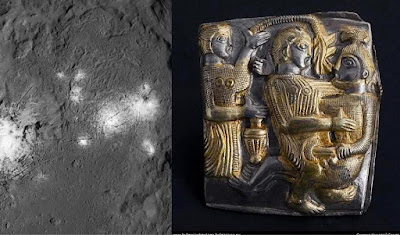




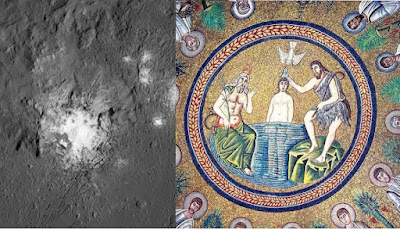



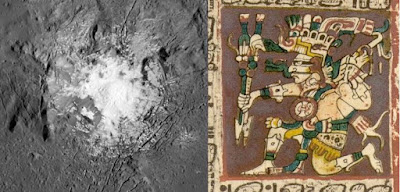

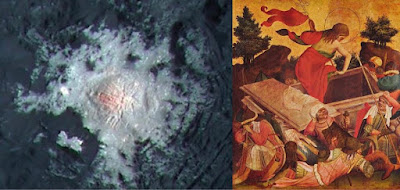







































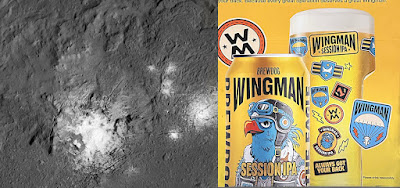
No comments:
Post a Comment